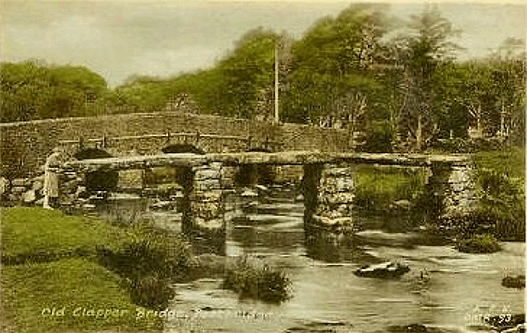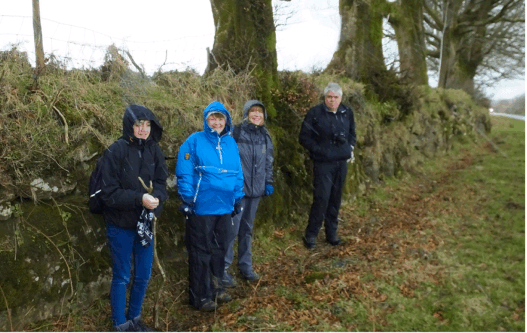
Two things you can depend on is firstly the unpredictability of Dartmoor’s weather and secondly when it rains it really can rain. Bearing this in mind there can be nothing more disappointing than planning a day on the Moor only to find out that when you get there you are going to get soaked. But ‘best laid plans of mice and men’ and all that, it’s a case of making the best of things no matter. What now follows is an account of such a day when a couple booked the services of James Perrott the Dartmoor guide for a tour around the Moor way back in 1868. It is interesting to read about the authors impressions and some of, what today may seem ridiculous, the historic theories of the time. It is impressive to see how under such dire weather conditions the author still managed to appreciate the beauty of Dartmoor despite a good soaking. It’s also worth noting that this tour took place in an “open sociable,” which in other words means a horse-drawn carriage open to all the elements.
“An anticipated visit to Dartmoor had been from circumstances delayed a fortnight too late; and instead of seeing it in the serenity of “the long sunny lapse of a summer day’s light,” my acquaintance with this wild and interesting district has been made at the time of the late equinoctial storms, when its rivers have been full, its skirting woods turning to gold, and the sky over-arching its wide and varied landscape has been itself an entangled picture of passing storms, piled up vapour, rainbows, and scattered outbursts of sunshine…
We were anxious to compare British archaic monuments with some we had examined in Brittany last year – the avenues of Carnac, the Menhirs at Dol &c., the cromlechs beneath the soil at Loemariaquer and Gavrinis. Both the points of resemblance and of difference between the Armoican and Danmonian antiquities are highly interesting; but it is not the intention at present to describe well-known remains, like those of the Cromlech at Drewsteinton, its neighbour, the deep secluded Bradmere Pool, the Sacred Circle at Fernworthy, the numerous Hut-circles, Pounds, and trackways scattered about the hill-sides, and the so-called Logan Stones, which as a general rule, will not “log.” and yet more questionable cavities in the granite, named Rock-basins. I will rather give a sketch of a day on the Moor – the pursuit of the beautiful and the antique under some difficulties.
The Stannary Church-town of Chagford does not I think boast of a barometer. We were consequently neither buoyed up by hope nor depressed with fear by the mercurial indications. We went boldly at the weather – “we” indicating my companion, a lady. We had already sustained on two or three occasions, exposure to a couple of hours rain at a time; and for four successive mornings a fine rainbow formed its arch opposite our windows. On the 30th of September the emblem of fear was particularly brilliant; and in addition to the “Shepherd’s Warning,” there had been a wet night. But the attractions of the Moor, in any weather and the desire to see the British Bridge at Postbridge overcame our considerations. Besides which there is a carriage road in this direction the whole way. In an open sociable, driven by Perrott, the invaluable Moor guide, we took our way at 11 o’clock towards the Dart. More rainbows, and a sky piled with thunderous masses of cloud, wild and fantastic in shape; very beautiful, but more than threatening. Half an hour after starting, and before we reached the Moor gate, a storm came on. We drew up by the side of the road for what shelter the tall hedge afforded, and had an opportunity of admiring, for the twentieth time, the verdant tufts of polypodium, lady fern, and Asplenium nigrum (Black Spleenwort) which deck most hedges, walls and tree-stumps in this part of Devon. Our umbrellas and such coverings as we had soon streamed with water, but after a quarter of an hour the rain ceased and we proceeded. We left our last cover, and passed the Moor gate; the sky funereal and cloud-entangled, but not without some shreds of blue and some rents through which sunshine broke out on the lower and far-distant landscape and bringing in fresh points of a glorious view. The faint dim shining of the sun on the interrupted peeps we had of cultivated country before us; the brown colour of part of the Moor where brake and heath had escaped being burnt during the dry summer; the frowning darkness of some of the hills, and the purple hue of others; the silence of the scene and the solitariness of the road; the strange crests of rock on many surrounding Tors, and then the rushing and swollen brooks hurrying to swell the rivers – formed an ensemble of impressive beauty and grandeur to be long remembered by us.
At last from the highest point, we saw Princetown, at a distance of six miles, the village adjoining Dartmoor Prison. We also caught sight of the small wayside inn, more than a mile away, close to the Dart, where we trusted to get shelter from the dark storm that was rushing towards us between the hills. Our guide and horse did their best in descending the long declivity, to save us from another drenching, but in vain. We were hurrying to meet our fate; and three or four minutes before we could gain our shelter we were again streaming with violent rain. We sprang off our carriage; and within four very humble walls, beside a peat fire, we ate bread and butter for lunch, and dried our clothes, and remained there weather-bound for three hours. Twice during that time we stole down to the river to examine the British bridge. It is some twenty yards lower down stream than the present bridge over which the coach road passes. This ancient work is in every respect a remarkable object – from the art and symmetry with which it is constructed; from the great size of the massive granite slabs which compose the footway; and from the its extreme uncertain age. Twenty centuries look down from the primeval hills on this small but important instalment of civilisation, which in its simple construction has resisted, through that or a longer time, the winter floods of the torrent-like Dart. Two piers, each composed of a double pile of stones, superimposed without cement, support the footway, which is some thirty inches wide. Gazing from this upon the river rushing beneath one is the more surprised that such simple architecture should so long have resisted the impulses and the friction of the water. The only injury the bridge has sustained was done by the hand of man; a farmer having thrown down a granite slab of the footway beyond three principal masses. The stone can be seen in the river bed, and it is a pity that it should not be restored in situ.

On our way we passed several British remains; the most impressive of these Grim’s Pound, was two miles distant from our road, and the weather was such that we could not make the necessary detour on foot through bog and brook to reach it; we saw it consequently only in outline on the hill-side, its wall enclosing many acres of land and many hut circles. We however passed close to several of these primitive dwelling-places of which there seemed to be quite a settlement with two stone trackways running to them, as if for the guidance of their inhabitants. The bridge already described would probably form part of the ground plan. Of later date are the stone lines called Stannary walls, marking old mining boundaries. The same strange fact presents itself to the mind here and at Penmarch in Brittany, that this wild, wet, exposed moorland, and that desolate sandy shore were once peopled and numerously populated too. However it seems that there is “health on the breeze.” Our hosts five younger children, strong and amphibious, well clothed and booted wandered in and out of the inn, stood in the road with the rain pouring on their fair curly heads, or in a ditch opposite through which a stream was flowing over their ankles. “Do you dry those children’s shoes at night?” I enquired. “No sir, We don’t take much notice of that, here by the Moor.” A small church and school are in the process of erection at Post-Bridge. These, though pretty, and constructed of granite, show a great decline in the art of building. The simple bridge has withstood the violence of the elements from, or even before, the Roman invasion; yet part of the church has fallen to the ground before the roof is completed.
At half-past four we ventured home ward. Behind us in the west the sky was gloomy and threatening, but the rain had eased. Before us the Moor was outspread, with its tors and valleys, its morasses and tributary streamlets; around us were its mimic Alps, Kestor, Cosden Beacon, the distant pile of Blackingstone, and many more of its prominent heights; and between some gaps we caught the far off cultivated uplands shining peaceful in the level evening light. The Moor may be easier to explore in dry, settled weather; but it could never look more beautiful than it did as we drove homeward; a perfect rainbow, with its double arch spanning the scene in front of the deep-coloured hills looked and lighting up a spot where it reached the ground. From the interrupted light, some of the ranges and masses of hills looked almost black, whilst others were bathed in ethereal purple. Beyond the middle distance of the wild, owing to the particular condition of the atmosphere the pretty little town o Moretonhampstead was seen distinctly nestling under the guardian hills; and we caught too – an unusual sight, it seems, so far off – the little wreath of white vapour marking the railway train passing the wood and “clatter” of Lustleigh Cleeve before reaching Morton. It was shortly after six o’clock when we reached our lodgings at Chagford. – John Bull Magazine, October 24th, 1868.

There are a couple of things here that need clarifying, when the author talks about; “two stone trackways,” these were in fact what today are known as ‘Reaves.’ Although in most cases they were constructed from stone and would have looked like trackways they are Bronze Age field boundaries. Secondly, the “stone lines called Stannary walls” are somewhat of a mystery as mining boundaries tended to be marked by single stones. As the author was writing about the Grimspound area it might have been possible for him to have seen the walled gardens used by the miners in order to keep out the Headland Warren rabbits? Lastly, it was not only in the 1860s that the tall hedges afforded shelter as can be seen above they still do today.
 Legendary Dartmoor The many aspects past and present of Dartmoor
Legendary Dartmoor The many aspects past and present of Dartmoor
